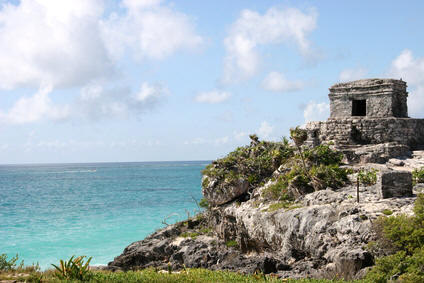The gentle murmur of the waves is a constant companion of the visitor to Tulúm, at the southern end of the Riviera Maya, Quintana Roo.
The remains of that great walled city that was once the commercial and religious center of the Mayans, still rises majestically upon a small cliff that offers incomparable views of the Caribbean Sea.

@Mindaugas Danys
The Mayans originally named this city Zamá, meaning sunrise or morning, and dedicated it to the planet Venus, which represented Kukulcan, or plumed serpent. Kukulcan was to the Mayans what Quetzalcoatl was to the Mexicas: a hero elevated to the category of deity, lord of the winds; the ruler of commerce and farming.

From the unobstructed panorama that Tulúm provides,the Mayans observed the heavens and paid special attention to the movement of the planet Venus as well as the rest of the heavenly bodies, and related it to the natural and social events of their environment.
Thus, they were able to predict the seasons for planting and harvesting, favorable dates for going to war or establishing alliances with neighboring cities.
On several of Tulúm’s buildings you’ll find images of Kukulcan plummeting down to earth.
Therefore, Tulúm was one of the most important cities in the Mayan World because of its strategic location, which served as a trading spot.
The Mayans were excellent navigators, so they established commercial trade routes for cocoa, salt, cotton, honey, ceramics, farm products, obsidian, turquoise, gold and copper.

Today, Tulúm is especially attractive for travelers because it combines the beauty of the Mexican Caribbean with the mysticism of the Mayan civilization.
Tulúm makes us ponder the close interaction that the Mayans had with the sea, the heavenly bodies and with nature.
You can still admire the mural paintings in the Temple of the Frescos. Tulúm is the third most visited archaeological zone in Mexico.
Recently, the National Institute of Anthropology and History installed lighting and audio tour equipment to offer tourists the magical experience of discovering Tulúm at Night. Sound, darkness and stars establish a dialogue with stone to tell the visitor how life once was in this beautiful city that still throbs between the jungle and the sea.
Angie Galicia
Location: Federal Highway 307 Chetumal–Puerto Juárez, Tulum, Quintana Roo, México. 128 kilometers south of Cancun and 64 km from Playa del Carmen.
How to get there: From Cancun and Playa del Carmen, go south on Federal Highway 307. ADO, Mayab y OCC bus routes have various schedules going from Cancun, Playa del Carmen and Chetumal.
Visiting time required: Half a day.
Visiting hours: 8:00 a.m. to 5:00 p.m. Tulúm at Night: 8 and 9 p.m.
Entry fee: $ 51.00 MXN (pesos). Tulum at night: $170.00 MXN
Guided Tours: There are tour guides within Tulúm certified by the National Institute of Anthropology and History (INAH) or by the Secretary of Tourism * Travel agencies offer guided tours including transportation from Cancun and Playa del Carmen.
Where to eat: El Tabano, on Beach Road, Tulum * Dolci Sapori, on Calle Centauro, Tulum * Hechizo, at the Sian Ka’an Biosphere entry.
Suggestions for shopping: The handicraft market at the entrance to the archaeological zone *The Shop in the archaeological zone.
What to take: Sun block * Insect repellent * comfortable shoes * sunglasses * a hat
* Light-colored, lightweight clothes * bathing suit * bottled water * camera * video camera (you will need to pay a small fee for a video recording permit upon entry)
Don’t miss: The Sian Ka’an Biosphere Reserve on the outskirts of Tulúm Xel-Ha, in Tulúm’s surrounding area Playa del Carmen’s La Quinta Avenida, near Tulúm.


